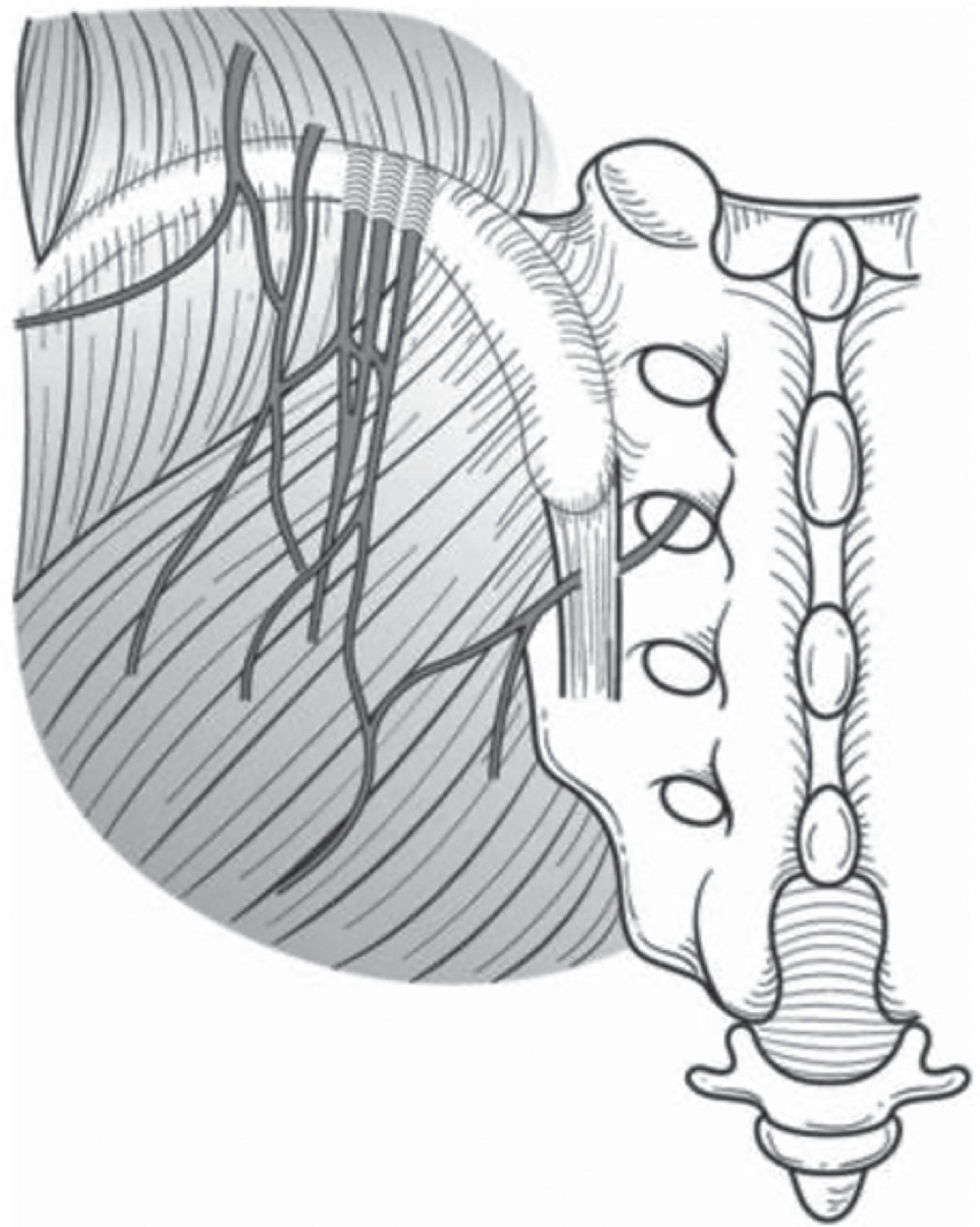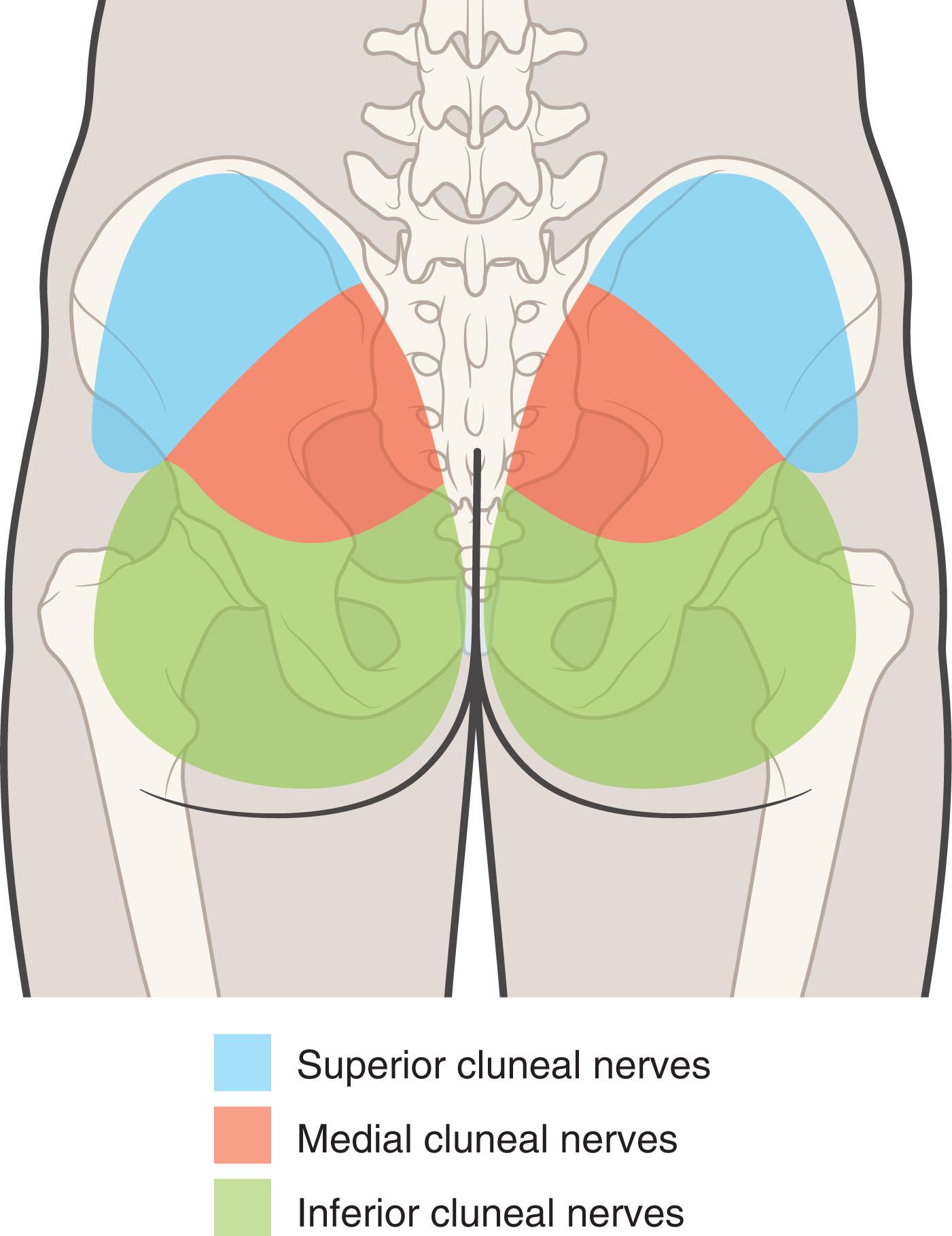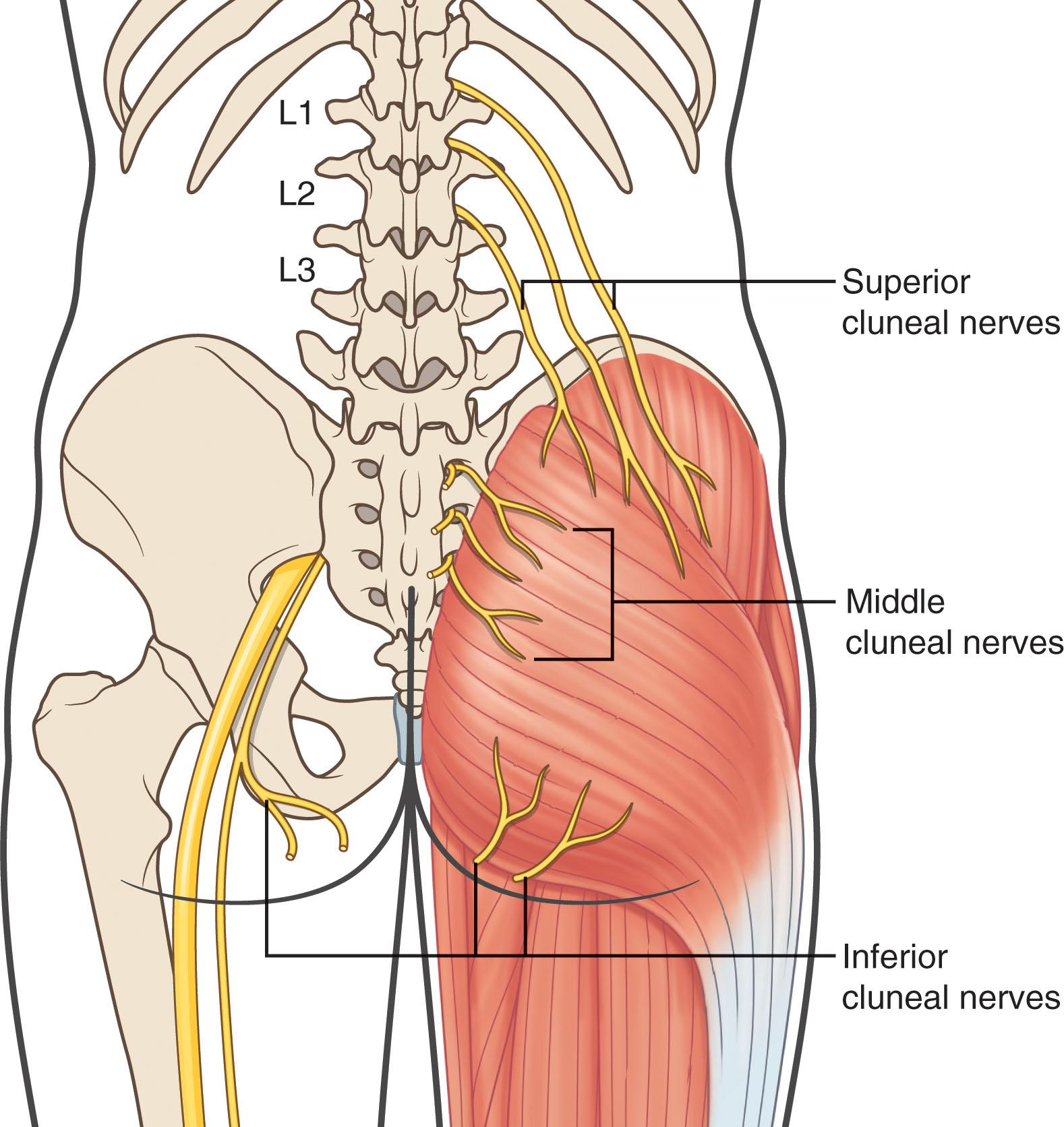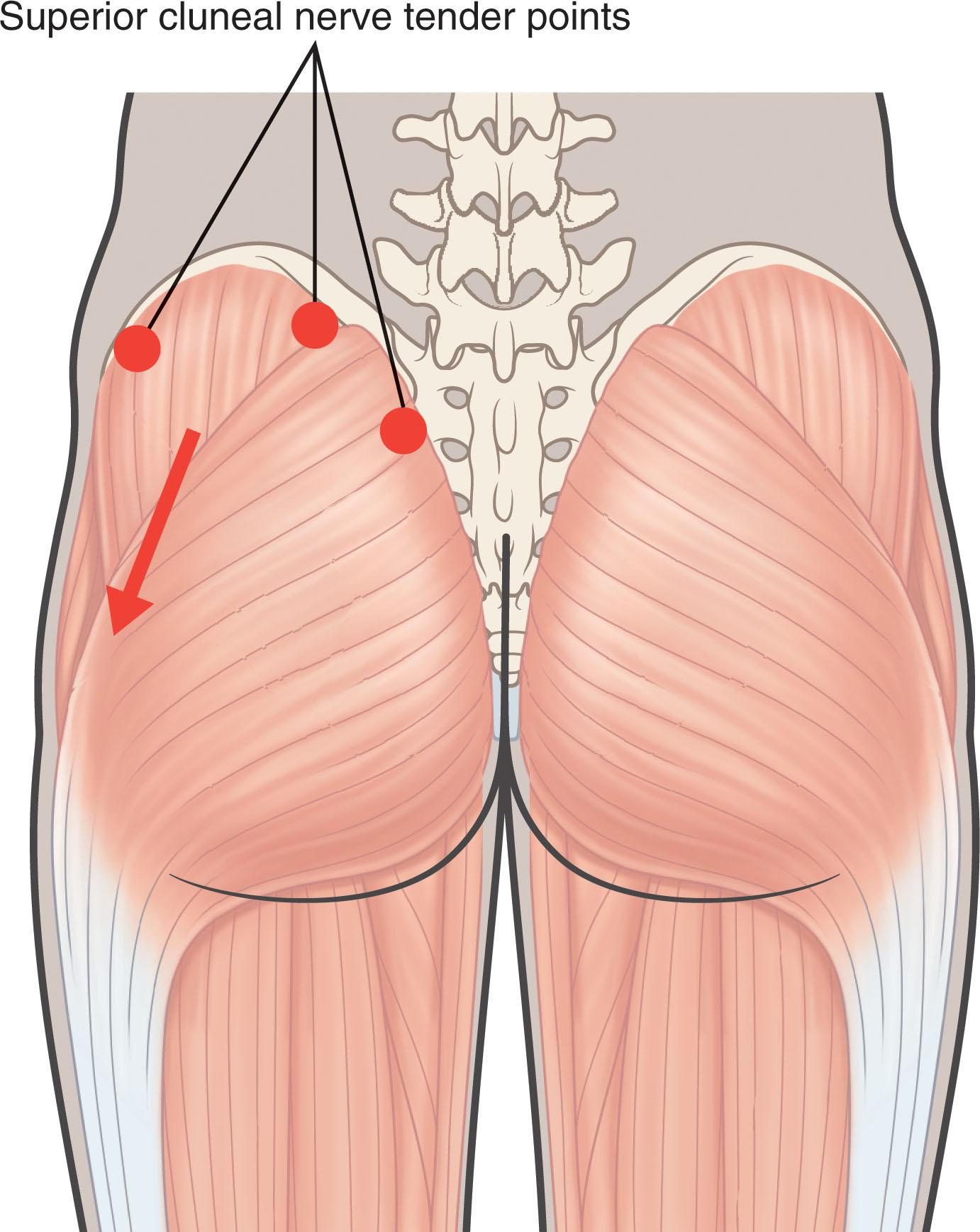Physical Address
304 North Cardinal St.
Dorchester Center, MA 02124
The superior cluneal nerve (SCN) is a group of nerves that originate from the cutaneous branches of the dorsal rami of T11-L4 ( Fig. 19.1 ). Iwnaga et al.’s cadaveric dissection found that the nerve can arise from L5 as well. The SCN has often been overlooked as a cause of or contributor to lower back pain as well as buttocks and leg pain. While it does not descend below the buttocks, the nerve can cause a referral pattern of pain that radiates down the leg. This phenomenon has been referred to as “pseudosciatica.” Despite the lack of attention, it is not a rare clinical entity, and superior cluneal nerve entrapment (SCN-E) syndrome should be considered as a potential cause of chronic low back pain or leg pain. Kuniya et al. found that 50% of patients suffering with SCN-E experienced leg pain.

The first detailed description of the cluneal nerves was made by Strong and Davila in 1957. However, it was Maigne et al. who popularized recognition of SCN-E syndrome, leading to the eponymous “Maigne’s syndrome.” Traditionally overlooked, SCN-E syndrome has recently been revisited with the increasing popularity of peripheral neuromodulation techniques. Many patients who have failed multiple spine therapies targeting traditional structures such as the medial branch nerves, facet joints, epidural space, nerve roots, sacroiliac joints, and trigger points have found relief with blockade of the SCNs.
Patients suffering from SCN-E will present with low back pain over the SCN-E points, with radiating pain or paresthesias in the distribution of the SCN ( Fig. 19.2 ). Tender points on the iliac crest may reproduce the patient’s chief complaint. Prior to the renewed interest in the SCN, many patients had often been dismissed as having a trigger point, sacroiliac joint pain, or other axial pathologies.

Injury to the branches of the SCN have occurred as a result of bone graft harvest from the posterior iliac crest for spinal fusion, but according to Trescot, the superior cluneal neuralgia was more commonly the result of a spontaneous entrapment of the nerve rather than that occurring during a bone harvest.
SCN-E neuropathy is a cause of unilateral lower back pain involving the iliac crest and buttocks. It is often misdiagnosed as a lumbar spine disorder. Low back pain due to SCN-E neuropathy can be exacerbated by lumbar extension. Trescot mentioned that SCN-E may cause pain in the lateral calf or foot, and this may contribute to the misdiagnosis of lumbar or sacral radiculopathy.
Kuniya et al. found that, out of 834 low back pain patients, 113 met the criteria for a SCN pathology. Suspected SCN disorders were diagnosed by identification of a maximal tender point on the posterior iliac crest 70 mm from midline and 45 mm from the posterior superior iliac spine (PSIS). Palpation of the maximally tender point reproduced the chief complaint of lower back and/or leg symptoms. Pain was often worse with rising from a sitting position, extension, bending, rotating, prolonged standing, sitting, walking, and rolling. Leg symptoms were found in 47% to 84% of patients, and Kuniya et al. noted that this can be confused with radiculopathy. In addition, intermittent claudication due to worsening back pain upon walking may occur.
In Kuniya and colleagues’ analysis, the SCN-E diagnosis had a significantly higher prevalence in patients with vertebral fractures than in the remaining 738 without compression fractures. L1 was the most reported level fractured level. Miki et al. suggested that 40% to 47% of SCN-E cases are accompanied by leg pain. This is consistent with the findings of Kuniya et al.
The incidence of SCN-E in patients with low back pain was high as 14% in Kuniya and colleagues’ study. Over 50% were females, and the average age at onset ranged from 55 to 68 years. Despite this, younger individuals and athletes have been reported to suffer from SCN-E. Miki et al. found that, compared with patients suffering from lumbar spinal stenosis (LSS), patients with SCN-E may have a higher rate of psychological problems than those suffering from lumbar disc herniation. This is theorized to be related to a long history of untreated pain secondary to misdiagnosed or unrecognized cluneal nerve entrapment. Other items in the Roland Morris Disability Questionnaire may suggest that patients with SCN-E display more dependent behavior than those suffering from LSS. This may be for the same reason.
The SCNs are derived from the cutaneous branches of the dorsal rami of T11-L4 (L5 has been noted in some reports). The SCNs and middle cluneal nerves are cutaneous, purely sensory nerves that may be connected. They provide sensory perception in the lumbar and buttock regions. The SCN courses superior-medial to inferior-lateral. The medial SCN branches penetrate the thoracolumbar fascia 3 to 4 cm from the midline. The middle SCN branches penetrate the thoracolumbar fascia 7 to 8 cm from the midline. Some of the fibers pass through the osteofibrous tunnel formed by the thoracolumbar fascia and iliac crest ( Figs. 19.1 and 19.3 ).

Maigne’s syndrome involves facet syndromes at the thoracolumbar junctions causing unilateral lower back pain. In a later cadaveric study, Maigne et al. noted that the lateral branches of the dorsal rami of T12, L1, and L2 (with a minority having an anastomosis from L3) innervated the skin of the lower back and displayed spontaneous entrapment of the most medial branch of the SCN in an osteofibrous tunnel in the space surround by the iliac crest and thoracolumbar fascia. Here, the pain was not experienced at the thoracolumbar junction but was referred lower to the dermatome of the corresponding cutaneous dorsal rami. Pressure on the iliac crest reproduced the pain and correlated with the emergence of the SCN into the iliac fossa.
The SCN may be found 6.6 to 8 cm from the midline in most patients. Upon evaluation, this must be distinguished from sacroiliac joint pain. According to Konno and colleagues’ cadaveric dissections, the mean linear distance from the PSIS to the SCN branches passing through the osteofibrous tunnel was 40.8 mm (17.8–66.3 mm), and the diameter of SCNs ranged from 0.3 to 2.9 mm (mean 1.6 mm) The functional basis for the symptoms of SCN-E includes a rigid fascial edge and stretching of the gluteus maximus muscle and skin over a larger area during flexion of the hip joint.
It has been suggested that 1.6% to 14.0% of all cases of back pain involve SCN-E neuropathy. Konno et al. examined 16 cadavers and evaluated SCN emergence from the nerve roots and then passage through the fascial attachment to the iliac crest. Some 81 SCN branches originating from T12 to L5 were identified, 13 of which passed through an osteofibrous tunnel. Of the 13 branches, two sides showed branches originating from L3, six sides from L4, and five sides from L5. Ten of the 13 branches showed macroscopic entrapment.
Radiology and electromyography cannot diagnose SCN-E neuropathy, yet they can exclude other pathologies, such as disc herniation, facet joint degeneration, tumor, and so on.
The diagnosis of SCN-E is made when relief is provided by a low-volume local anesthetic diagnostic nerve block targeting the entrapped branches of the SCN. Patients will often present with low back pain involving the iliac crest and buttocks, as well as an aggravation of symptoms with posture changes. A tender point or trigger point over the posterior iliac crest corresponding to the nerve compression zone may be noted ( Fig. 19.4 ). Patients may also report numbness and radiating pain when the trigger point is compressed (Tinel’s sign). The diagnostic criteria outlined by Isu et al. include:
Low back pain at the iliac crest and buttocks
Symptoms exacerbated by lumbar puncture or posture
Trigger point over the PSIS (corresponding to the nerve compression zone)
Numbness and radiating pain in the SCN area when the trigger point is compressed (Tinel’s sign)
Relief with SCN injection.

Diagnostic blockade of the SCN can be performed using landmarks, ultrasound, or fluoroscopy. Fluoroscopy provides the location of important boney landmarks such as the iliac crest and PSIS. Ultrasound provides imaging of these landmarks, as well as the opportunity to visualize the nerve in real time.
Become a Clinical Tree membership for Full access and enjoy Unlimited articles
If you are a member. Log in here